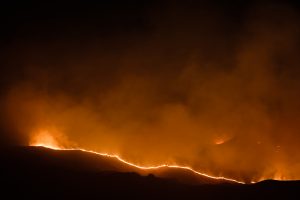Studying spatial-temporal patterns of wildfire spread throughout California
 Wildfire in California is a natural disturbance that has long been ingrained in the history of the state. Given the various dimensions of wildfire threat, impacting natural ecosystems, built infrastructure, numerous communities, and transportation networks, it is essential to map, rank and identify location-specific wildfire hazards. Analyzing and understanding wildfire spatial-temporal patterns and trends enhances our ability to allocate resource and prioritize hazard and risk mitigation efforts in areas most vulnerable to large, catastrophic fires.
Wildfire in California is a natural disturbance that has long been ingrained in the history of the state. Given the various dimensions of wildfire threat, impacting natural ecosystems, built infrastructure, numerous communities, and transportation networks, it is essential to map, rank and identify location-specific wildfire hazards. Analyzing and understanding wildfire spatial-temporal patterns and trends enhances our ability to allocate resource and prioritize hazard and risk mitigation efforts in areas most vulnerable to large, catastrophic fires.
Since the fire risk that different communities face is dynamic and evolving through time, we map and analyze past wildfire occurrences and model predicted future occurrences, in three dimensions (3D), across a continuum of space and time, highlighting areas most likely to be affected by wildfires. We believe that looking at the spatial and temporal neighbors of predicted wildfire occurrences, and mapping wildfire hot spot patterns statewide not only enhances our understanding of California’s dynamic wildfire regimes, but also helps identify areas where fire risk is projected to increase, decrease, or remain the same.
